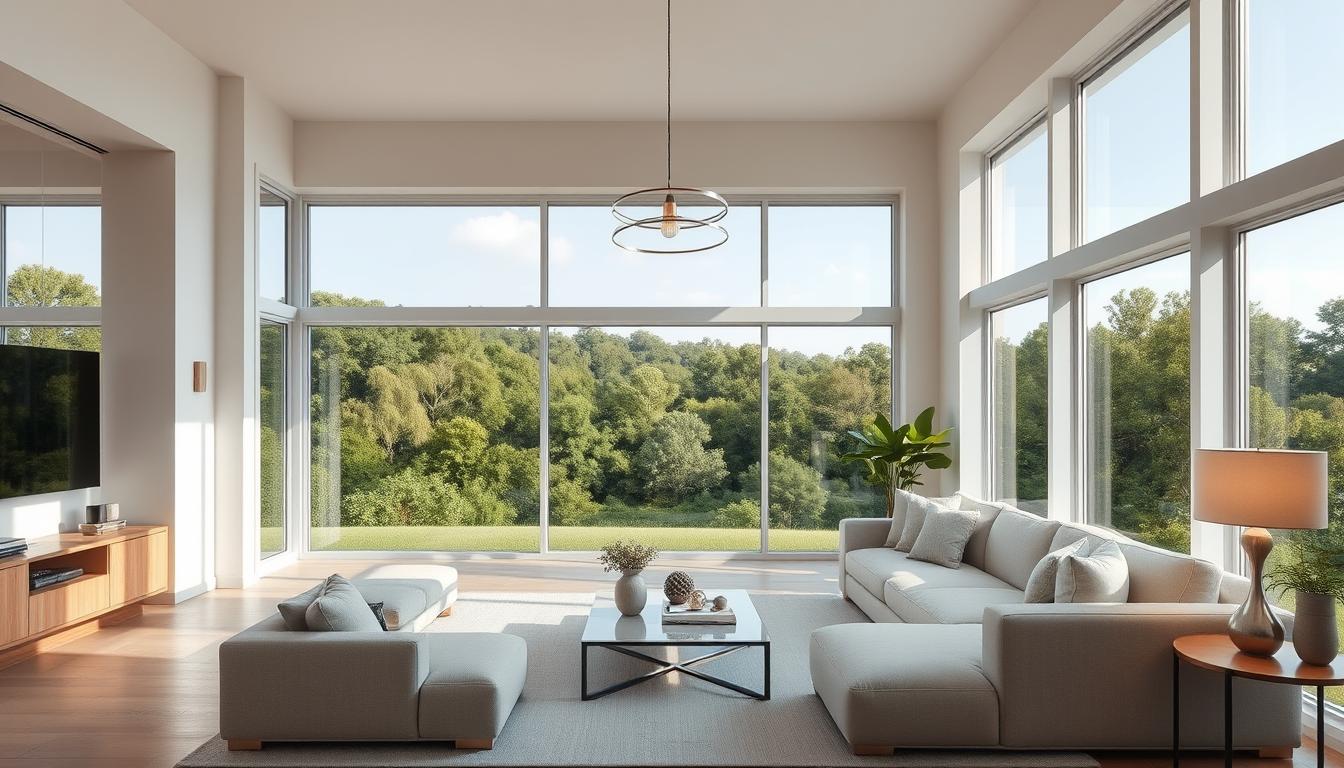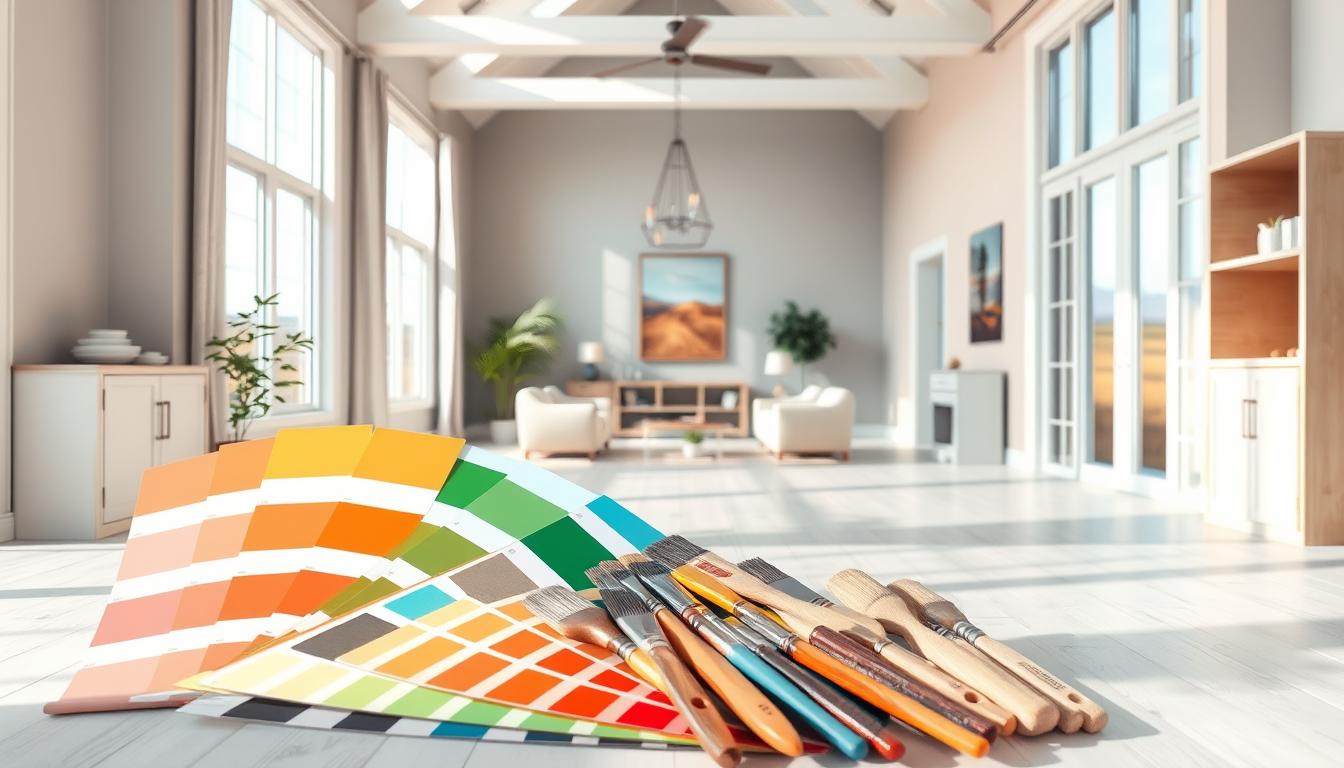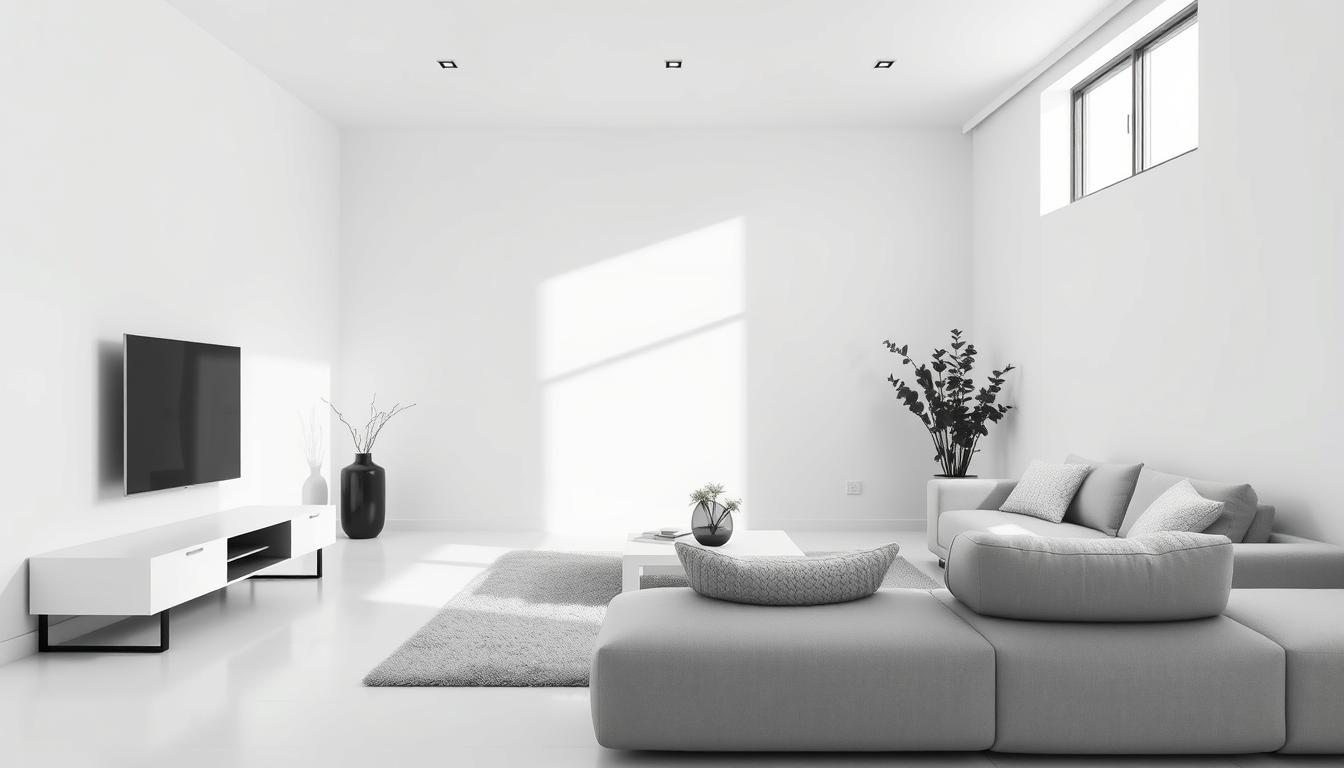Did you know a well-designed living space can make you happier and more productive? We’ve been digging into the best home decor ideas. Now, we’re ready to share our top tips for a stylish and welcoming home.
Finding your unique style is a journey. It’s key to trust the process and have fun along the way. With our help, you’ll turn your space into a cozy haven that shows off your personality and meets your needs.
Key Takeaways
- Discover the importance of trusting the design process
- Learn how to create a stylish and inviting atmosphere
- Explore expert tips for transforming your living space
- Understand the significance of finding your unique style
- Enjoy the journey to creating a haven that reflects your personality
Understanding the Basics of Interior Home Design
A well-designed home starts with knowing the basics of interior design. It’s about making a space that works well and looks good.
Modern home interiors aim to balance looks and function. It’s not just about style; it’s about making sure the space meets our needs.
The Importance of Functionality
Functionality is key in interior design. A space that’s hard to use is frustrating, no matter how it looks. We must think about how we’ll use the space and plan it out.
For example, a living room should be cozy and good for socializing. We should pick furniture that’s both stylish and comfy, fitting the room well.
| Design Element | Functional Consideration | Aesthetic Consideration |
|---|---|---|
| Furniture | Comfort, scale, and purpose | Style, material, and color |
| Lighting | Task lighting, ambient lighting | Type of fixtures, brightness, and color temperature |
| Color Scheme | Psychological impact, spatial perception | Harmony, contrast, and personal preference |
Balancing Aesthetics and Practicality
It’s important to balance looks and use in house interior design. We want a space that looks great but also works well.
Using interior design services can help. They can make a space fit our needs, mixing modern styles with practicality.
Adding stylish storage can keep things tidy without losing style. This way, we can have both order and beauty in our homes.
Defining Your Personal Style
Defining your personal style is key to making your home reflect you. It’s about knowing what you like and what you don’t. Then, you can create a space that feels like home.
Exploring Different Design Styles
To find your personal style, explore various design styles. Look into styles like modern, traditional, and everything in between. You can find interior design inspiration in magazines, online, and even in nature.
Popular styles include minimalist, industrial, and bohemian. Each style has its own look. For example, minimalist focuses on simplicity, while industrial uses exposed brick and metal.
Identifying Your Preferences
After looking at different styles, identify what you prefer. Think about what you like and dislike in each style. Consider your lifestyle and needs too.
For example, if you have a busy home, you might want practical designs. If you love to entertain, choose layouts that are open and inviting.
To make your home reflect your style, use home renovation ideas that match your taste. Update your furniture, add new textiles, or change your layout. The goal is to have a stylish home interior that’s truly yours.
By defining your personal style, you can make your home not just look good but feel like your own. It’s about finding a balance between looks and function, making your space work for you.
Color Theory in Home Design
Color theory is key in interior home design. It shapes the feel and look of a space. It’s about how colors work together and with room elements.
Choosing the right colors is vital when designing a home. Colors can change how we feel and see a space. Cool colors like blue and green calm us down. Warm colors like red and orange energize us.
Choosing the Right Color Palette
Think about each room’s purpose when picking colors. Bedrooms need soothing colors for relaxation. Home offices need energizing colors for focus.
For more tips on picking colors, check out this guide on color theory in interior design.
Harmonizing Colors with Space
After picking colors, make sure they match the space. Think about the room’s lighting, furniture, and decor.
A good color scheme makes a room feel connected and smooth. Design experts say a harmonious scheme is pleasing and balanced.
“The right color can transform a room, making it feel larger, cozier, or more vibrant.”
| Color | Effect | Best Used In |
|---|---|---|
| Blue | Calming | Bedrooms, Bathrooms |
| Red | Energizing | Living Rooms, Kitchens |
| Green | Balancing | Home Offices, Living Rooms |
By using color theory, we can design a house interior design that’s both stunning and practical. Whether you want a contemporary interior design or a classic look, the right colors are crucial.
Maximizing Space with Smart Design
Maximizing space means using smart layouts and choosing the right furniture. It’s not just about the room’s size. It’s how you use it that matters.
Effective Layout Strategies
A good layout is key to making the most of your space. Here are some tips:
- Keep things simple to avoid clutter and make the space feel bigger.
- Choose furniture that does more than one thing.
- Think about how people move around your home and arrange furniture to help.
Furniture Arrangement Tips
How you arrange your furniture is important for space. Here are some tips:
- Find the room’s main focus, like a fireplace or view.
- Place furniture around it to balance and harmonize the space.
- Make sure your furniture fits well with the room’s size.
Using these effective layout strategies and furniture arrangement tips can make your living area feel bigger and more useful. It will also show off your style and meet your needs.
For more home decor ideas and interior decorating tips, look into different styles. Also, talk to experts to get the modern home interiors you want.
Lighting: The Key to Atmosphere
A well-designed lighting plan can make a room look better and feel warmer. Lighting is key in interior design, shaping a room’s feel.
Types of Lighting to Consider
There are many lighting types for different effects. Ambient lighting lights up the whole room. Task lighting helps with specific tasks, like reading. Accent lighting shines on special features or areas.
Combining these lights creates a rich, interesting look. For example, a living room might use ceiling lights for overall light, table lamps for reading, and spotlights on art.
Layering Light for Depth
Layering light makes a space look good and work well. Mixing light sources adds depth and interest. This includes overhead lights, table lamps, floor lamps, and string lights.
In a kitchen, layering light means using overhead lights for general light, under-cabinet lights for countertops, and pendant lights over the island. This makes the kitchen both useful and beautiful, giving interior design inspiration for updates.
With careful lighting planning, you can make a space that’s both useful and stylish. It follows the rules of stylish home interiors and offers great home renovation ideas.
Incorporating Textures and Patterns
To add depth and visual interest to a space, using various textures and patterns is key in contemporary interior design. This not only makes the space look better but also makes it feel unique and welcoming.
Using Textiles to Add Warmth
Textiles are vital in making a room warm and cozy. Mixing fabrics like velvet, linen, and cotton creates a layered, inviting space. For example, plush throw blankets, soft rugs, and comfy upholstery can really warm up a room.
Tips for Using Textiles:
- Mix different textures to create visual interest.
- Choose fabrics that complement the color palette.
- Layer textiles to add depth to a room.
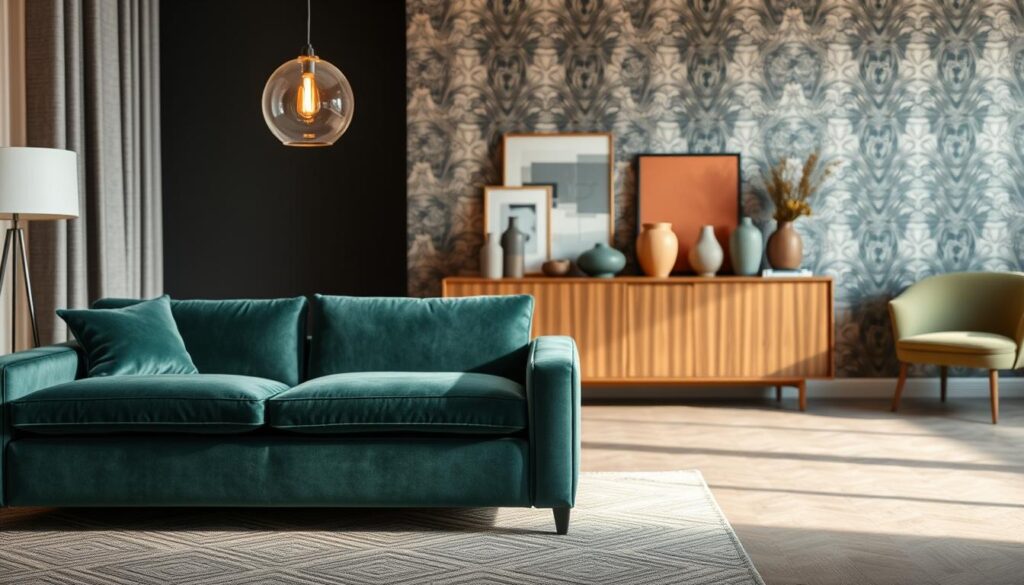
Combining Patterns for Visual Interest
Combining patterns is an art that can make a room visually interesting. It’s important to balance patterns with solids to avoid overwhelming the space. A well-balanced mix of patterns can make your interior design dynamic and engaging.
Guidelines for Combining Patterns:
- Start with a dominant pattern and complement it with smaller, secondary patterns.
- Use a unifying color to tie different patterns together.
- Balance bold patterns with neutral solids.
| Pattern Type | Best Used With | Effect |
|---|---|---|
| Stripes | Solids, Florals | Creates a classic, timeless look |
| Floral | Stripes, Geometries | Adds a touch of elegance and sophistication |
| Geometric | Solids, Abstracts | Creates a modern, dynamic atmosphere |
By carefully choosing textures and patterns, you can make a house interior design that looks great and shows off your personal style.
Furniture Selection and Placement
Choosing and arranging furniture greatly affects our living space’s look. A well-designed room is both beautiful and functional. It’s key to pick and place furniture wisely.
Key Considerations for Selecting Furniture
When picking furniture, think about both looks and use. We should find pieces that match our style and are practical. For example, a stylish sofa can be both a statement and a comfy seat.
Quality matters too. Good furniture lasts longer, saving us money. Also, furniture size should fit the room well to avoid clutter or emptiness.
Arranging Furniture for Optimal Flow
Arranging furniture for flow means making a natural path through the room. Think about the room’s purpose and activities. For a living room, arrange seats for talking and coziness.
Using a balanced layout helps flow too. This means spreading furniture and decor’s visual weight for harmony. Mix big and small pieces, and colors and textures for depth.
By carefully choosing and arranging furniture, we make a space that’s both lovely and useful. This improves our daily life and shows our personal style.
Creating a Cohesive Design
A cohesive design is key to a stylish home. It’s when every part works together in perfect harmony. This creates a space that looks good and shows off your personal style.
The Role of Consistency
Consistency is vital for a cohesive design. You can achieve this by picking a theme or style that ties everything together. For example, choosing a design style like modern or traditional helps keep your home looking consistent.
To keep things consistent, think about these tips:
- Choose a main color scheme and use it everywhere in your home.
- Pick furniture that has similar design features, like clean lines or ornate details.
- Use the same textures and patterns to add depth and interest.
Unifying Themes and Elements
Unifying themes and elements create a story in your home. This can be done by adding elements that show your personal style or interests. For instance, if you love to travel, use souvenirs or maps as decor.
- Know your personal style and preferences.
- Find a few key pieces that reflect your style and build your design around them.
- Use accessories and decor to connect different rooms and spaces.
By focusing on a cohesive design, you can make your home stylish and welcoming. Whether you’re renovating or just need interior design inspiration, consistency and unifying themes are key to a beautiful home.
Adding Personal Touches
To make your space truly unique, add personal touches that share your story. Your home should mirror your personality, interests, and experiences. By adding personal elements to your interior home design, your house will feel like home.
Displaying Art and Decor
Displaying art and decor that speaks to you is a great way to add a personal touch. This could be a collection of artwork, sculptures, or decorative items that show your style. Think about how these pieces will look in your space.
A bold art piece can be a room’s centerpiece. A collection of small items can add interest to a shelf or mantle.
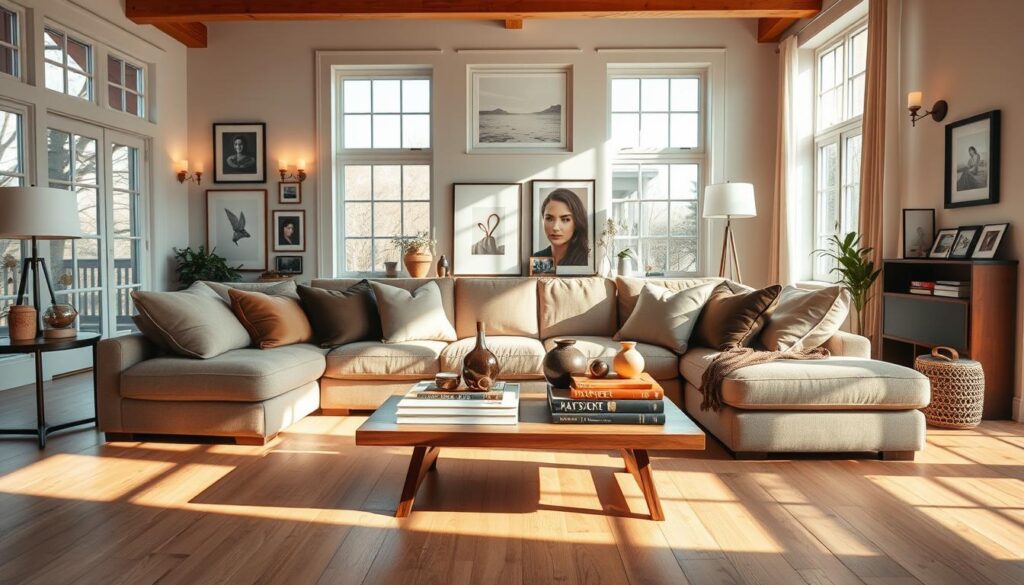
Personalizing with Family Heirlooms
Incorporating family heirlooms is another meaningful way to personalize your space. These items bring history and warmth, connecting you to your heritage. They could be a vintage piece, a handmade quilt, or jewelry.
Display them proudly or weave them into your decor in a way that feels special to you. This approach to contemporary interior design makes your space a true reflection of you.
Sustainable Interior Design Choices
Sustainable interior design is now a must for those who want to lessen their environmental impact.
By carefully choosing materials and solutions, we help the planet and make our homes better. This means picking eco-friendly materials and using energy-efficient solutions.
Eco-Friendly Materials
Picking the right materials is key in sustainable design. Eco-friendly materials are those that are good for the planet. They include:
- Bamboo flooring
- Recycled glass countertops
- Sustainably sourced wood
These materials help our homes be kinder to the environment. They also bring beauty and texture to our spaces.
Energy-Efficient Solutions
Being energy-efficient is also vital in sustainable design. Energy-efficient solutions help us use less energy and save money.
| Solution | Description | Benefits |
|---|---|---|
| LED Lighting | Uses light-emitting diodes (LEDs) to produce light | Energy-efficient, long-lasting |
| Smart Thermostats | Automatically adjusts heating and cooling based on your schedule | Reduces energy waste, saves money |
| Energy-Efficient Appliances | Designed to use less energy while maintaining performance | Lowers utility bills, reduces environmental impact |
By choosing wisely, we can make our homes more sustainable and lovely. This shows our dedication to the environment.
Accessories to Elevate Your Space
Accessories are key in interior design. They let you add special touches to your space. By picking the right decor and adding plants, you can make your space feel fresh and welcoming. It will show off your personal style.
Choosing Decor Wisely
When picking accessories, think about the look you want. Choose pieces that match your decor and add your own flair. Here are some tips:
- Choose items that show your taste and style.
- Think about the size of the accessory in your room.
- Use different textures and materials to make your space richer.
Using Plants for a Fresh Look
Adding plants to your decor is a smart move. Plants clean the air and bring calm to your home. Here’s how to use plants well:
- Pick easy-to-care-for plants like succulents for busy spots.
- Use plants with different textures and sizes for interest.
- Put plants in places where you can see and enjoy them.
By adding the right accessories and plants, you can make your space stylish. It will show off your unique taste. For more interior design inspiration, look into different home renovation ideas. They can help you get the look you want.
The Importance of Planning
Effective interior home design needs careful planning. This ensures a stylish and functional space. We’ve looked at many aspects, like defining your style and using textures and patterns. A good plan is key for success.
Creating a mood board is a great step in contemporary interior design. It lets you see your ideas and what you like. By using images, fabrics, and other things that inspire you, you get a clear direction for your design.
Visualizing Your Design
A mood board helps organize your thoughts. It makes sure your design is cohesive. It’s also useful for sharing your vision with designers, contractors, or suppliers.
Budgeting for Success
Setting a realistic budget is vital in interior home design. Knowing your budget helps you make smart choices about materials, furniture, and more. This keeps your design on track.
With a clear vision and a well-planned budget, you can create a beautiful and functional space. It will reflect your personal style perfectly.

